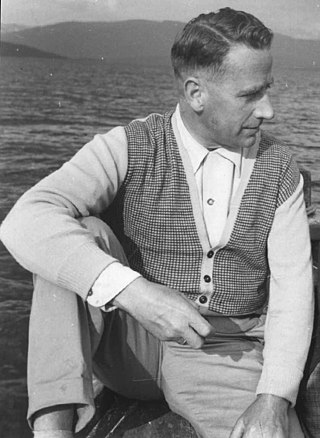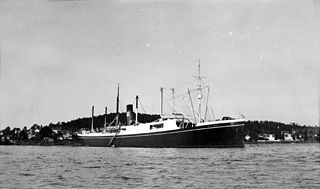
Josef Antonius Heinrich Terboven was a Nazi Party official and politician who was the long-serving Gauleiter of Gau Essen and the Reichskommissar for Norway during the German occupation.

Narvik is the third-largest municipality in Nordland county, Norway, by population. The administrative centre of the municipality is the town of Narvik. Some of the notable villages in the municipality include Ankenesstranda, Ballangen, Beisfjord, Bjerkvik, Bjørnfjell, Elvegård, Kjøpsvik, Skjomen, Håkvik, Hergot, Straumsnes, and Vidrek. The Elvegårdsmoen army camp is located near Bjerkvik.

Neuengamme was a network of Nazi concentration camps in Northern Germany that consisted of the main camp, Neuengamme, and more than 85 satellite camps. Established in 1938 near the village of Neuengamme in the Bergedorf district of Hamburg, the Neuengamme camp became the largest concentration camp in Northwest Germany. Over 100,000 prisoners came through Neuengamme and its subcamps, 24 of which were for women. The verified death toll is 42,900: 14,000 in the main camp, 12,800 in the subcamps, and 16,100 in the death marches and bombings during the final weeks of World War II. Following Germany's defeat in 1945, the British Army used the site as an internment camp for SS and other Nazi officials. In 1948, the British transferred the land to the Free Hanseatic City of Hamburg, which summarily demolished the camp's wooden barracks and built in its stead a prison cell block, converting the former concentration camp site into two state prisons operated by the Hamburg authorities from 1950 to 2004. Following protests by various groups of survivors and allies, the site now serves as a memorial. It is situated 15 km southeast of the centre of Hamburg.
Sydspissen detention camp was a Nazi concentration camp in Tromsø, Norway, which operated briefly during World War II. Serving as the primary prison camp in northern Norway, it quickly became overcrowded and is now considered to have had some of the worst conditions of any camp under the German occupation. The prisoners were eventually relocated a short distance away to Tromsdalen detention camp. The camp was used to hold Nazi collaborators after the war, some of whom were badly mistreated. There are no known photographs of the concentration camp; however, a painting in Tromsø Forsvarsmuseeum details the camp during the summer of 1941, prior to the construction of an additional barracks for prisoners and a residence for the camp commander.

Hans Loritz was an officer in the Schutzstaffel (SS) who was the commandant of several concentration camps in Germany and Nazi-occupied Europe. He committed suicide in captivity after the war.
Beisfjord is a village in Narvik Municipality in Nordland county, Norway. The village is located about 15 kilometres (9.3 mi) southeast of the town of Narvik, at the southeastern end of the 11-kilometre (6.8 mi) long Beisfjorden. The village sits in a valley surrounded by steep mountains, with the Lakselva river flowing through it and emptying into the fjord. The 0.69-square-kilometre (170-acre) village has a population (2021) of 828.

Nazi concentration camps in Norway were concentration camps or prisons in Norway established or taken over by the Quisling regime and Nazi German authorities during the German occupation of Norway that began on 9 April 1940 and used for internment of persons by the Nazi authorities. 709 prison camps or concentration camps, [including some death camps,] were counted by a project that had Randi Bratteli, as an advisor. Another source has claimed that there were around 620 prison camps.
Tromsdalen detention camp, colloquially known as Krøkebærsletta, was a Nazi concentration camp just east of Tromsø, Norway, built during World War II. From November 1942 until the end of the occupation of Norway in May 1945, it was primarily a transit camp for prisoners on their way to Falstad, Grini, or camps in Nazi Germany. It held over 2000 recorded prisoners.

The German occupation of Norway began on 9 April 1940. In 1942, there were at least 2,173 Jews in Norway. At least 775 of them were arrested, detained and/or deported. More than half of the Norwegians who died in camps in Germany were Jews. 742 Jews were murdered in the camps and 23 Jews died as a result of extrajudicial execution, murder and suicide during the war, bringing the total of Jewish Norwegian dead to at least 765, comprising 230 complete households.

Prior to the deportation of individuals of Jewish background to the concentration camps there were at least 2,173 Jews in Norway. During the Nazi occupation of Norway 772 of these were arrested, detained, and/or deported, most of them sent to Auschwitz. 742 were murdered in the camps, 23 died as a result of extrajudicial execution, murder, and suicide during the war. Between 28 and 34 of those deported survived their continued imprisonment. The Norwegian police and German authorities kept records of these victims, and so, researchers were able to compile information about the deportees.

Asbjørn Nesheim was a Norwegian linguist and curator known for his research on the Sámi languages and cultural history, particularly for his collaboration with Konrad Nielsen on volumes four and five of Nielsen's Lapp Dictionary. Nesheim was also responsible for creating and building up a Sámi Department at the Norsk Folkemuseum in Oslo from the 1950s on.

Skorpa prisoner of war camp was a facility built by the Norwegian 6th Division to hold German prisoners of war during the 1940 Norwegian Campaign of the Second World War. Skorpa was the main PoW camp in Northern Norway and held around 500 civilian and military prisoners when it was shut down at the end of the Norwegian Campaign.

Hirden was a uniformed paramilitary organisation during the occupation of Norway by Nazi Germany, modelled the same way as the German Sturmabteilungen.
Bjørnfjell is a mountain and village of holiday cottages in Narvik Municipality in Nordland county, Norway. It's located along the Ofotbanen railway line and the European route E10 highway, just west of the border with Sweden. There is a railway station and the Bjørnfjell Chapel as well as many cabins and homes in the area. The name Bjørnfjell for short may often refer to the Bjørnfjell Railway Station. The area is a popular vacation spot for residents of Narvik.

The kvarstad vessels were a number of Norwegian ships held in arrest in Gothenburg during World War II. The ships had been visiting Swedish ports when the German invasion of Norway took place in April 1940. They were eventually claimed by Nortraship, which represented the Norwegian exile government and the British Government, but also by the Germany-supported Quisling regime in Norway. The fate of the ships was disputed through a number of diplomatic notes and trials between the involved parties. The disputed vessels originally numbered 42 ships, with a total of 170,000 ton dw. Some of the ships returned early to occupied Norway, some after recommendation from the Administrative Council. In January 1941 the British Operation Rubble succeeded in bringing five of the ships to the Orkney Islands.

(Norwegian), Kárášjohka (Northern Sami), or Kaarasjoki (Kven) is the administrative centre of Karasjok Municipality in Troms og Finnmark county, Norway. The village is located along both sides of the Karasjohka river, just 12 kilometres (7.5 mi) west of the Norway-Finland border. The European route E06 highway runs through the village on its way from Lakselv to Tana bru and Kirkenes. The 2.19-square-kilometre (540-acre) village has a population (2017) of 1,844 which gives the village a population density of 842 inhabitants per square kilometre (2,180/sq mi).
The SS Ski Jäger Battalion "Norway" was a combat battalion unit within the German Waffen-SS, the armed wing of the Schutzstaffel. It consisted of a majority of volunteers from Norway, and some enlisted German soldiers. Most officers and non-commissioned officers were Norwegian.

Sophus Magdalon Buck Kahrs was a Norwegian commander in the German SS during the Nazi era. Following the war, he was convicted for treason.
The European Defence League (EDL) is a largely UK-based offshoot of the English Defence League founded by Tommy Robinson which campaigns against what it considers sharia law and itself has various offshoots. The group was set up in October 2010 and held its first demonstration that month in Amsterdam, Netherlands, at the trial of Dutch anti-Islam politician Geert Wilders.

The Blood Road is a route northeast of Rognan in the municipality of Saltdal in Nordland county, Norway that was built by prisoners during the Second World War. The route was a new section of Norwegian National Road 50 between Rognan and Langset on the east side of Saltdal Fjord (Saltdalsfjorden), where there was a ferry service before the war. The specific incident that gave the road its name was a cross of blood that was painted on a rock cutting in June 1943. The blood came from a prisoner that was shot along the route, and the cross was painted by his brother.














